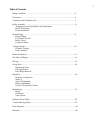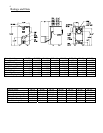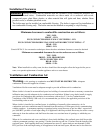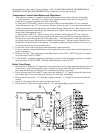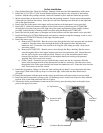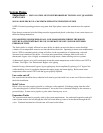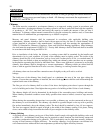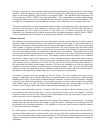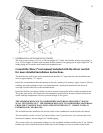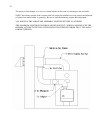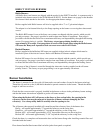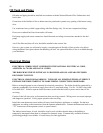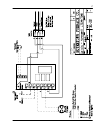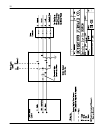11
Evidence of potential or existing chimney damage should be determined by visual inspection of the chimney
and liner. Exterior indicators such as missing or loose mortar/bricks, white deposits on the brick or water
stains on the interior building walls should be investigated further. The operational flue temperatures for
boilers range from 350
º
F to 450
º
F at the outlet of the boiler. These temperatures are further reduced before
reaching the chimney due to heat loss through the vent connector and dilution from the draft regulator. The
resulting flue gas temperatures may become low enough to form condensation on the chimney liner walls.
To prevent condensation, it is necessary that the internal chimney wall temperature always be kept above the
dew point of the flue gasses. If the chimney is a masonry type, it may have to be lined with a flue liner, if
the temperature loss is too great for the boiler. A liner will act as an insulator and reduce the flue gas
temperature loss. Insulation may be added around the liner for further temperature stability. Refer to NFPA-
31 for recommended liner sizing tables as developed by the Oil Heat Vent Analysis Program.
Chimney Connector
The chimney connector pipe between the boiler and chimney shall be of equal diameter as the flue outlet of
the boiler. Refer to boiler specifications in this manual for proper size flue pipe for your model boiler. Any
reduction in size required for the chimney must be made at the chimney connector. The vent connector pipe
must be made of 24 gauge (or thicker) corrosion-resistant steel. The vent connector pipe should be as short
as possible and installed so that it has a continuous rise from the boiler to the chimney. Long horizontal vent
runs can result in the possibility of condensation in the flue pipe or the chimney. All horizontal runs of vent
connector pipe should be pitched upward a minimum of 1/4 inch per foot of run. The horizontal length of
the vent pipe connector shall not exceed 10 feet. The chimney connector shall be installed so as to minimize
the number of elbows and to avoid sharp turns or other construction features that would create excessive
resistance to the flow of flue gasses. Tees may be used in a straight section in conjunction with a barometric
draft regulator; however, they must not be used for a 90° turn. No device that will obstruct the free flow of
flue gasses shall be installed in the chimney connector. This does not exclude the use of devices specifically
designed for the use in chimney connectors such as automatic dampers. The vent pipe should be joined
with metal screws and supported by straps. A thimble should be used to connect the vent connector pipe to
the chimney so the pipe may be readily removed in case of inspection or replacement.
No chimney connector shall pass through any floor or ceiling. The vent connector pipe must not pass
through a combustible wall or partition unless they are guarded at the point of passage by a ventilated metal
thimble not less than 12 inches larger in diameter than the connector, on metal or fireclay thimbles adequate
protection is provided at the passageway. An acceptable passageway could be either an approved, ventilated
metal thimble which is at least 12 inches larger in diameter than the vent connector pipe, or brick work
which is at least 8 inches thick constructed into the wall and surrounding the vent connector
Clearances from combustible materials or materials shall be in accordance with the clearances given. The
vent connector pipe should extend only to (and not beyond) the inside wall of the chimney. A thimble
should be used to connect the vent connector pipe to the chimney so that the vent connector pipe may be
readily removed in case of inspection or replacement.
Connection to the chimney must be made above the bottom of the chimney to avoid blockage. Vent piping
should extend just into the chimney far enough to expel flue gasses. Inserting the vent piping too far into
the chimney will cause undue obstruction. Use a thimble or a slip joint where vent pipe enters the chimney
to allow easy removal for cleaning.
If a draft regulator is required in the vent piping; it should be located at least 24 inches from the boiler if
possible in either a horizontal or vertical section of the vent pipe. The draft regulator must be installed in the
same room as the boiler and in such a manner that there is no difference in pressure between the air in the
vicinity to the regulator and the combustion air supply. Ensure that the barometric damper is accessible for
adjustment.



